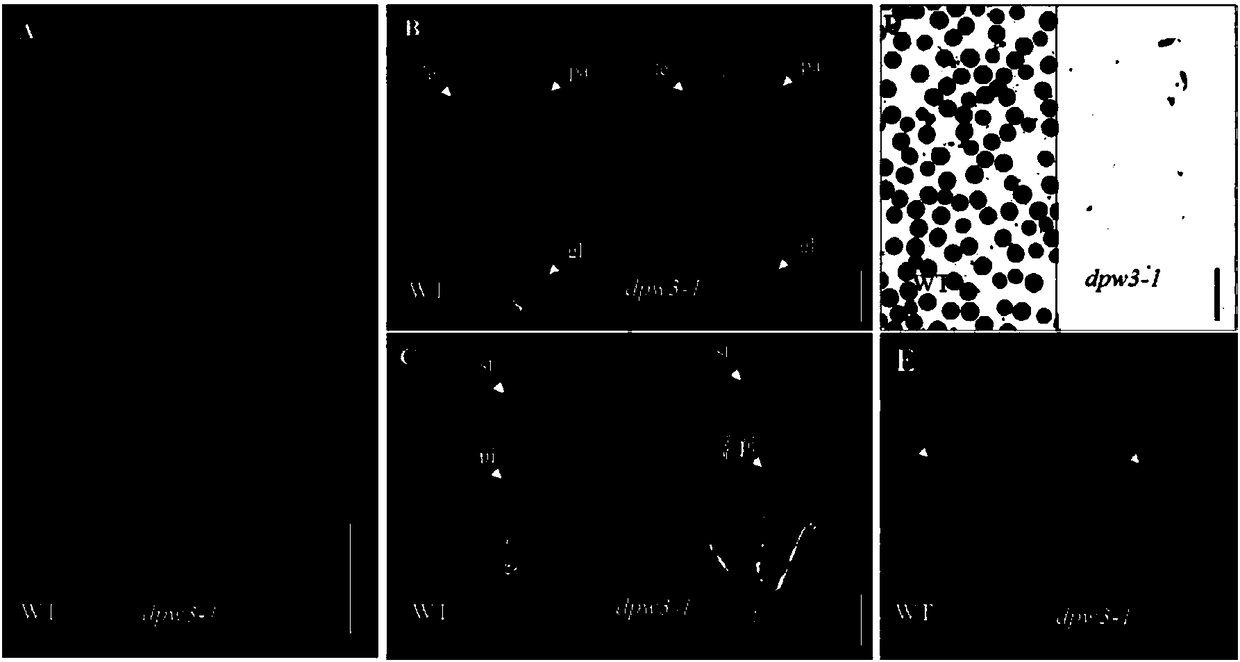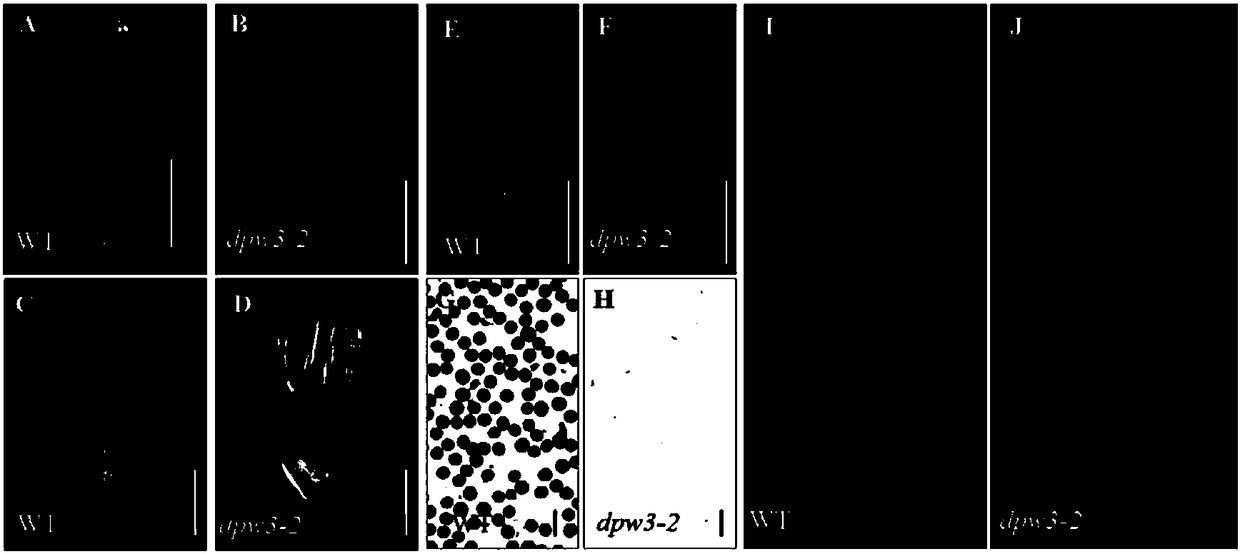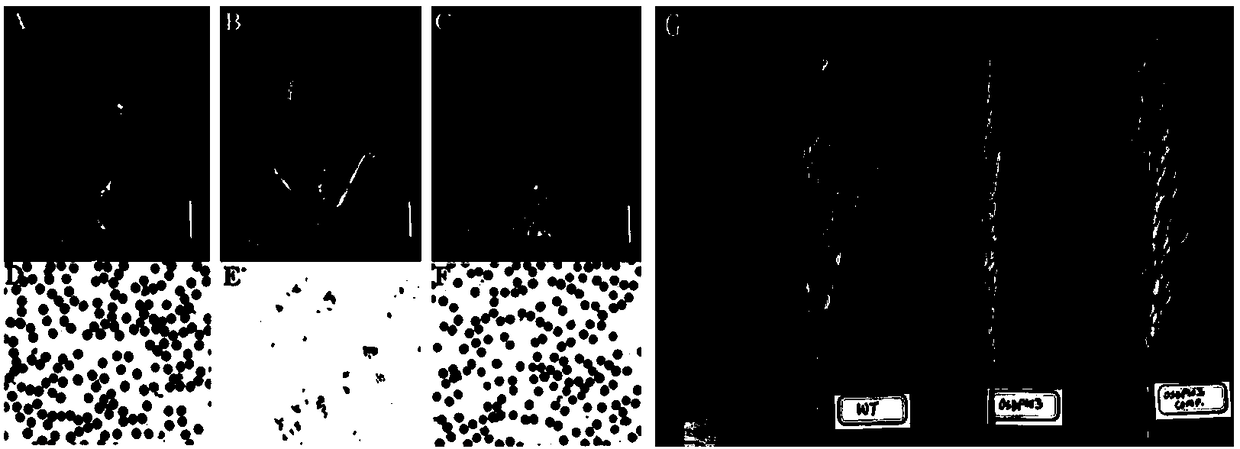Application of male sterility gene OsDPW3 and rice fertility restoration method
A technology of male sterility gene and male sterility, which is applied in application, genetic engineering, plant genetic improvement, etc., can solve the limitation of restorer line and maintainer line relationship, the difficulty of screening excellent combinations, and the complex performance of three-line hybrid rice seeds. and other issues to achieve the effect of improving production efficiency and reducing labor costs
- Summary
- Abstract
- Description
- Claims
- Application Information
AI Technical Summary
Problems solved by technology
Method used
Image
Examples
Embodiment 1
[0043] Embodiment 1, the method of rice male sterile line creation
[0044] 1.1 Creation of osdpw3 rice male sterile line by conventional breeding methods
[0045] The osdpw3-1 mutant material in this example is obtained from a conventional japonica rice variety Wuyujing No. 7 (also known as 9522) through a conventional genetic engineering method.
[0046] Those skilled in the art know that other methods such as irradiation can also be used to mutate conventional rice varieties. If the osdpw3-1 mutant is mutated, it will lead to frameshift and premature termination of the encoded protein, which will also lead to male reproduction in rice. Organ anthers do not develop normally. The mutagenized mutants were backcrossed for three generations to obtain a stably inherited osdpw3-1 mutant controlled by a recessive nuclear single gene. The osdpw3-1 mutant was backcrossed with 9522, and all F1 generations had the same phenotype as 9522 and appeared fertile. The segregation ratio ...
Embodiment 2
[0069] Example 2. Use of osdpw3 mutants in rice seed production
[0070] The osdpw3-1 mutant was crossed as the male parent with the sterile parent in the three-line or two-line cross combination to obtain the F1 generation. Plants with both male-sterile and sterile characteristics are selected in the F2 generation, and the plants are crossed with the maintainer line corresponding to the original sterile parent. The plants with both male sterility and sterility are screened again in the F2 generation to cross with the maintainer line, and a new male sterile line is obtained after multi-generation cross screening, which is suitable as the female parent in the hybrid combination.
Embodiment 3
[0071] Example 3. Method for restoring male sterility of osdpw3 mutants
[0072] The genomic nucleotide sequence encoding the OsDPW3 gene was transformed into the osdpw3-1 mutant plant, which could restore the mutant to the wild-type phenotype.
[0073] Genomic DNA was extracted from leaves of wild-type 9522 seedlings as template, using primers:
[0074] 70025gDNAF (its sequence is shown in SEQ ID NO. 7):
[0075] CCATGATTAC GAATTC TATTGCCTGTTTGTGGCTGGAC;
[0076] 70025gDNAR (its sequence is shown in SEQ ID NO. 8):
[0077] ATTCGAGCT GGTCACC GCCGCTTACACGTTACTGTATTGG;
[0078] Amplify the genome sequence fragment of 9120bp as shown in SEQ ID NO.6 of the OsDPW3 gene;
[0079] The amplified DNA fragment was inserted into the binary vector pCAMBIA1301 vector used for rice transformation through the In-Fusion transformation system of Dalian Bao Bio Co. ) EHA105 to obtain OsDPW3 complementary Agrobacterium tumefaciens (Agrobacterium tumefaciens) EHA105, and use genetic tr...
PUM
 Login to View More
Login to View More Abstract
Description
Claims
Application Information
 Login to View More
Login to View More - R&D
- Intellectual Property
- Life Sciences
- Materials
- Tech Scout
- Unparalleled Data Quality
- Higher Quality Content
- 60% Fewer Hallucinations
Browse by: Latest US Patents, China's latest patents, Technical Efficacy Thesaurus, Application Domain, Technology Topic, Popular Technical Reports.
© 2025 PatSnap. All rights reserved.Legal|Privacy policy|Modern Slavery Act Transparency Statement|Sitemap|About US| Contact US: help@patsnap.com



